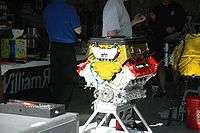Honda Indy V8
The Honda Indy V8 is a prototype four-stroke 3.5-litre normally-aspirated V8 racing engine, developed and produced by HPD-AHM Co. in partnership with Ilmor Engineering (reassembly, arrangement, preparation, maintenance, trackside support and tune-up) for IndyCar Series. Honda Indy V8 was a highly-successful IndyCar Series engine supplier from 2003 to 2011 seasons before replaced by Honda Indy V6 at the following season. Honda Indy V8 was unveiled at 2002 Detroit Auto Show and assembled at HPD power assembly plant in Santa Clarita, California, USA in early 2003.
| Honda Indy V8 | |
|---|---|
 | |
| Overview | |
| Manufacturer | HPD-AHM Co. (under a support of Ilmor Engineering) |
| Production | 2003-2011 |
| Layout | |
| Configuration | V8 normally-aspirated, 90° cylinder angle |
| Displacement | 3.5 L (214 cu in) (2003, 2007-2011) 3.0 L (183 cu in) (2004-2006) |
| Cylinder bore | 93 mm (3.66 in) |
| Block material | Aluminum alloy |
| Head material | Aluminum alloy |
| Valvetrain | 32-valve (four-valves per cylinder), DOHC |
| Combustion | |
| Turbocharger | No |
| Fuel system | Electronic indirect multi-point port fuel injection |
| Management | Motorola (2003-2010) McLaren (2011) |
| Fuel type | 100% fuel grade Ethanol provided by Sunoco |
| Oil system | Dry sump |
| Cooling system | Single water pump |
| Output | |
| Power output | 670 hp (500 kW) (2003-2006) 650 hp (485 kW) (2007-mid 2009) 650 + 20 hp (485 + 15 kW) with push-to-pass (mid 2009-end 2009) 650 + 40 hp (485 + 30 kW) with push-to-pass (2010-2011) |
| Torque output | Approx. 430 N⋅m (317 ft⋅lbf) @ 8,000 rpm |
| Dimensions | |
| Dry weight | 280 lb (127 kg) excluding headers, clutch, ECU, spark box or filters |
| Chronology | |
| Predecessor | Honda Turbo V8 |
| Successor | Honda Indy V6 |
1st Generation (2003-2004)
Honda debuted IndyCar Series as engine supplier in 2003 season after a CART successful era. Developed jointly by HPD with under support from Ilmor and designated as HI3R, engine's capacity was 3.5-liter. Honda supplied Andretti Green Racing, Team Rahal, Fernández Racing and Access Motorsports teams. Honda's 2003 stats were 3 pole positions, 6 fastest laps and 2 wins. A revised engine named HI4R was used in 2004 until new regulations came into effect at the 2004 Indianapolis 500.[1]
Applications
- Dallara IR3
- G-Force GF09
2nd Generation (2004-2006)
Honda designed a new engine to address the 2004 IRL rule change which required reduced displacement. Developed once again by Ilmor and designated as HI4R-A,[2] its capacity was 3.0-liter and debuted at the 2004 Indianapolis 500.[3] With subsequent evolutions named HI5R and HI6R, Honda was clearly dominant engine, scoring 33 poles, 35 fastest laps, 41 wins totally in three seasons including 3 Indianapolis 500s. Since Chevrolet and Toyota leaves IndyCar Series after 2005 season, Honda won exclusive tender IndyCar Series engine supplier for 2006 to 2011 season.
Applications
- Dallara IR4
- Panoz GF09B
- Panoz PZ09C
3rd Generation (2007-2011)
This family was designed as a replacement for the HI6R but enlarged to better accommodate variable valve timing and Active Fuel Management while still generating good performance. HI7R-HI11R's capacity reverted to 3.5-liters respectively since 2007 season.[4] HI7R-HI11R engine was developed and assembled by Honda in Santa Clarita, California, USA (Honda Performance Development's current headquarters) but remained under support from Ilmor Engineering for partial design R&D, trackside support, engine arrangement, tune up and engine maintenance. HI7R-HI11R engine supplied for all IndyCar Series teams. HI7R-HI11R was highly-successful engine with 86 pole positions, fastest laps and wins respectively including 2008 Nikon Indy 300 exhibition race and 5 Indianapolis 500s. Due to the IndyCar Series chassis and engine development freeze beginning in 2008, IndyCar Series kept the Honda Indy V8 3rd generation model until 2011 season for cost reasons. The combustion of Honda Indy V8 was four-stroke piston Otto cycle.
Year 2011 final specifications
- Engine type: Normally aspirated, fuel-injected, aluminum alloy 90-degree V-8
- Displacement: 3.5 litres (213.6 cubic inches)
- Valve train: Dual overhead camshaft, four valves per cylinder, finger-follower actuated coil spring/valve assembly
- Crankshaft: Steel alloy, five main bearings
- Pistons: Billet aluminum alloy
- Connecting rods: Machined steel alloy
- Engine management: McLaren Electronics Engine Control Unit (ECU) with engine strategies by Honda Performance Development (previously Motorola in 2003-2010)
- Ignition system: Digital inductive
- Injection system: Single injector per cylinder, fed by an engine-driven mechanical fuel pump (electronic indirect ported multi-point)
- Lubrication: Combined pressure and scavenge system featuring an oil pressure stage, multi-stage oil scavenge with an oil/air separator. Most cars utilize either and oil bypass or an oil thermostat for precise engine temperature control
- Cooling: Single mechanical water pump feeding a single-sided cooling system
- Transmission: Six-speed sequential, paddle-shift
- Fuel: 100% fuel-grade ethanol by Sunoco
- Weight: 275 lb (124.7 kg)
Applications
- Dallara IR5
Honours
On February 10, 2012 Honda Indy V8 was honoured as "North American Race Engine of the Year" by Race Engine Magazine.[5]
References
- "Indy: Honda's 2004 Engine". HondaBeat.com. September 10, 2004.
- "2004 Indy 500: BorgWarner Louis Schwitzer Award Presented to Honda". The Auto Channel. May 21, 2004.
- "Honda Unveils Stout Lineup to Defend IRL Titles". Honda Motor Co. January 19, 2005.
- "IRL to revert to 3.5-litre engines". Autosport. Autosport.com. August 31, 2006. Retrieved August 31, 2006.
- "Honda Indy V8 Honored by Race Engine Magazine". Honda Motor Company. 2012-02-10. Retrieved 2012-02-10.